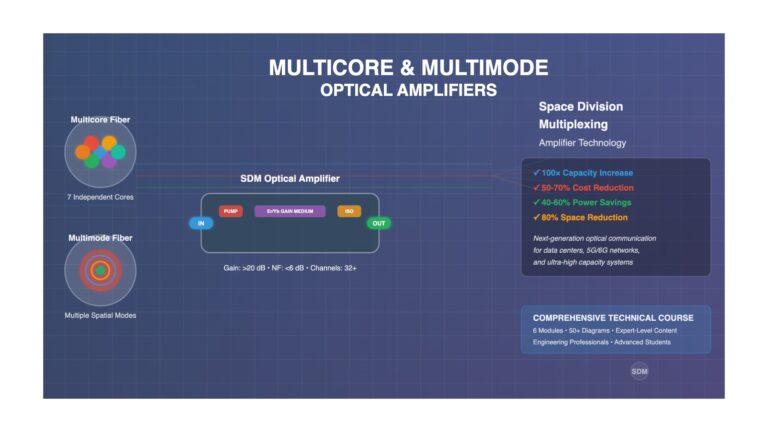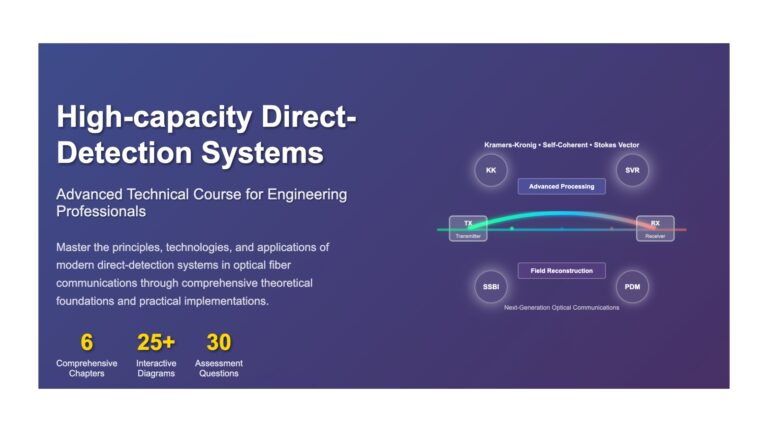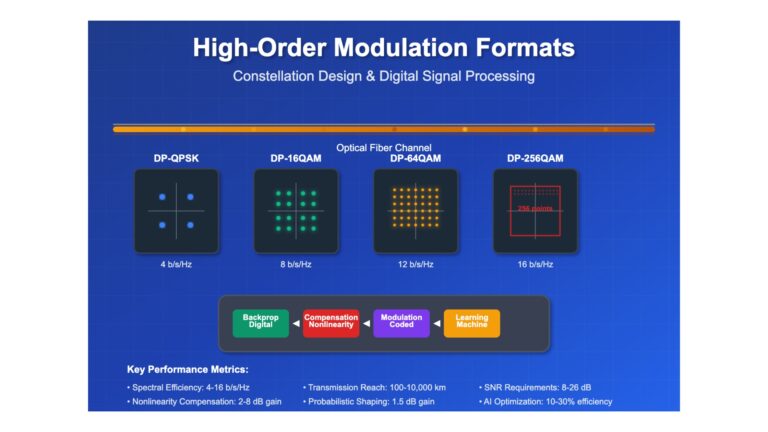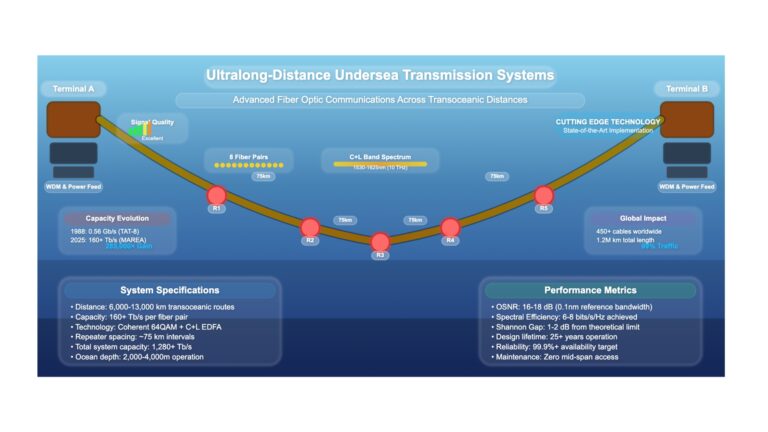Nonlinear Effects in Optical Fiber: Advanced Concepts and Applications
Course Description
This comprehensive course explores the complex phenomena of nonlinear effects in optical fiber communications. As optical networks evolve to meet increasing bandwidth demands, understanding these nonlinear behaviors becomes critical for network engineers, designers, and operators. Through detailed explanations and practical examples, students will learn the physics behind fiber nonlinearities, their impact on transmission performance, and cutting-edge techniques for measurement and mitigation.
Target Audience
- Optical network engineers and designers
- Telecommunications professionals
- Network operators and planners
- Graduate students in optical communications
- R&D professionals in the optical networking industry
Prerequisites
- Basic understanding of fiber optic transmission principles
- Familiarity with optical network architectures
- Fundamental knowledge of digital communications concepts
- Basic mathematical background (calculus and differential equations)
Learning Objectives
Upon completion of this course, students will be able to:
- Explain the physical origins of nonlinear effects in optical fiber
- Distinguish between different types of nonlinear effects and their impact on system performance
- Calculate and predict nonlinear thresholds for various system configurations
- Analyze the performance limitations imposed by nonlinearities
- Implement monitoring techniques to identify and characterize nonlinear effects
- Apply mitigation strategies at the fiber, system, and digital levels
- Evaluate emerging technologies and approaches for next-generation optical networks
Course Format
- 10 comprehensive chapters with detailed explanations
- Visual diagrams and illustrations of key concepts
- Knowledge check questions at the end of each chapter
- Case studies from industry implementations
- References to current research and standards
Course Outline
Chapter 1: Introduction to Nonlinear Effects in Optical Fiber
- The importance of understanding nonlinear effects
- Optical transmission fundamentals and the OSNR challenge
- Linear vs. nonlinear regimes
- The nonlinear challenge in modern optical networks
Chapter 2: Physics of Fiber Nonlinearity
- Introduction to nonlinear phenomena in optical fiber
- Classification of nonlinear effects
- The Kerr effect and nonlinear refractive index
- Quantifying nonlinearity
Chapter 3: Elastic Nonlinear Effects: Self-Phase Modulation (SPM)
- Physical mechanism of SPM
- Temporal and spectral effects
- SPM and chirping
- Interaction between SPM and dispersion
- Impact on different modulation formats
- Measuring and monitoring SPM
Chapter 4: Elastic Nonlinear Effects: Cross-Phase Modulation (XPM)
- Physical mechanism of XPM
- Comparing XPM and SPM
- Factors influencing XPM strength
- XPM interaction with dispersion
- Impact on system performance
- XPM mitigation techniques
- Monitoring and measuring XPM
Chapter 5: Elastic Nonlinear Effects: Four-Wave Mixing (FWM)
- Physical mechanism of FWM
- FWM products and their impact
- Factors affecting FWM efficiency
- The challenge of equal channel spacing
- Unequal channel spacing strategies
- FWM impact on system performance
- FWM mitigation strategies
- Measuring and monitoring FWM
Chapter 6: Inelastic Nonlinear Effects: Stimulated Raman Scattering (SRS)
- Physical mechanism of SRS
- SRS in single-band vs. multi-band systems
- Steady-state vs. transient SRS effects
- SRS impact on system performance
- SRS compensation strategies
- SRS in advanced system architectures
- Measuring and monitoring SRS effects
- Recent advances in SRS management
Chapter 7: Inelastic Nonlinear Effects: Stimulated Brillouin Scattering (SBS)
- Physical mechanism of SBS
- Comparing SBS with SRS
- SBS threshold and power limitations
- Guided Acoustic Wave Brillouin Scattering (GAWBS)
- Impact of SBS and GAWBS on system performance
- SBS mitigation techniques
- Measuring and monitoring SBS
- Recent research on GAWBS
Chapter 8: Monitoring and Measurement Techniques for Nonlinear Effects
- The importance of nonlinear monitoring
- Laboratory characterization techniques
- Nonlinear monitoring in deployed networks
- Monitoring specific nonlinear effects
- Advanced monitoring techniques
- Case studies in nonlinear monitoring
- Interpreting nonlinear monitoring data
Chapter 9: Mitigation Strategies and Compensation Methods
- The mitigation hierarchy: a comprehensive approach
- Fiber design and selection
- System architecture strategies
- Digital signal processing compensation
- Specific strategies for different nonlinear effects
- Modulation format and coding strategies
- Case study: commercial transceiver implementations
- Future directions in nonlinear mitigation
- Practical implementation considerations
Chapter 10: Industry Trends and Advanced Topics
- Hollow core fiber technology
- Digital twins and machine learning
- Multi-band transmission systems
- Advanced modulation techniques
- Future multiplexing techniques
- Nonlinear effects in next-generation systems
- Industry standardization and collaboration
Assessment Methods
- Chapter quizzes (30%)
- Mid-term examination (30%)
- Final project: System design with nonlinear considerations (40%)
Course Materials
- Primary: Course notes and diagrams provided in the LMS
- Supplementary textbooks:
- “Nonlinear Fiber Optics” by G.P. Agrawal
- “Optical Fiber Telecommunications VII” edited by A. Willner
- Research papers and industry white papers (links provided in the LMS)
Instructional Approach
The course employs a mix of theoretical foundations and practical applications. Each topic is introduced with fundamental concepts before progressing to practical implications and real-world examples. Visual aids, interactive diagrams, and case studies enhance the learning experience. Knowledge checks throughout the course ensure comprehension before advancing to more complex topics.
Technical Requirements
- Internet access for LMS content
- PDF reader for supplementary materials
- Optional: Access to optical system simulation software (e.g., VPIphotonics, OptiSystem)
Estimated Completion Time
- 40-50 hours total (including assessment activities)
- Recommended pace: 1-2 chapters per week over 5-10 weeks
Certification
Upon successful completion of all assessments with a minimum average score of 70%, students will receive a certificate in “Advanced Optical Network Design: Nonlinear Effects in Optical Fiber.”
Curriculum
- 11 Sections
- 91 Lessons
- 10 Weeks
- Chapter 1: Introduction to Nonlinear Effects in Optical Fiber5
- Chapter 2: Physics of Fiber Nonlinearity5
- Chapter 3: Elastic Nonlinear Effects: Self-Phase Modulation (SPM)8
- Chapter 4: Elastic Nonlinear Effects: Cross-Phase Modulation (XPM)9
- 4.14.1 Introduction to Cross-Phase Modulation
- 4.24.2 Physical Mechanism of XPM
- 4.34.3 Comparing XPM and SPM
- 4.44.4 Factors Influencing XPM Strength
- 4.54.5 XPM Interaction with Dispersion
- 4.64.6 Impact of XPM on System Performance
- 4.74.7 XPM Mitigation Techniques
- 4.84.8 Monitoring and Measuring XPM
- 4.94.9 Chapter Summary
- Chapter 5: Elastic Nonlinear Effects: Four-Wave Mixing (FWM)10
- 5.15.1 Introduction to Four-Wave Mixing
- 5.25.2 Physical Mechanism of FWM
- 5.35.3 FWM Products and Their Impact
- 5.45.4 Factors Affecting FWM Efficiency
- 5.55.5 The Challenge of Equal Channel Spacing
- 5.65.6 Unequal Channel Spacing Strategies
- 5.75.7 FWM Impact on System Performance
- 5.85.8 FWM Mitigation Strategies
- 5.95.9 Measuring and Monitoring FWM
- 5.105.10 Chapter Summary
- Chapter 6: Inelastic Nonlinear Effects: Stimulated Raman Scattering (SRS)10
- 6.16.1 Introduction to Stimulated Raman Scattering
- 6.26.2 Physical Mechanism of SRS
- 6.36.3 SRS in Single-Band vs. Multi-Band Systems
- 6.46.4 Steady-State vs. Transient SRS Effects
- 6.56.5 SRS Impact on System Performance
- 6.66.6 SRS Compensation Strategies
- 6.76.7 SRS in Advanced System Architectures
- 6.86.8 Measuring and Monitoring SRS Effects
- 6.96.9 Recent Advances in SRS Management
- 6.106.10 Chapter Summary
- Chapter 7: Inelastic Nonlinear Effects: Stimulated Brillouin Scattering (SBS)10
- 7.17.1 Introduction to Stimulated Brillouin Scattering
- 7.27.2 Physical Mechanism of SBS
- 7.37.3 Comparing SBS with SRS
- 7.47.4 SBS Threshold and Power Limitations
- 7.57.5 Guided Acoustic Wave Brillouin Scattering (GAWBS)
- 7.67.6 Impact of SBS and GAWBS on System Performance
- 7.77.7 SBS Mitigation Techniques
- 7.87.8 Measuring and Monitoring SBS
- 7.97.9 Recent Research on GAWBS
- 7.107.10 Chapter Summary
- Chapter 8: Monitoring and Measurement Techniques for Nonlinear Effects10
- 8.18.1 Introduction to Nonlinear Effects Monitoring
- 8.28.2 The Importance of Nonlinear Monitoring
- 8.38.3 Laboratory Characterization Techniques
- 8.48.4 Nonlinear Monitoring in Deployed Networks
- 8.58.5 Monitoring Specific Nonlinear Effects
- 8.68.6 Advanced Monitoring Techniques
- 8.78.7 Case Study: SPM/XPM Laboratory Monitoring
- 8.88.8 Case Study: Digital Twin for SRS Monitoring in C+L Band Systems
- 8.98.9 Interpreting Nonlinear Monitoring Data
- 8.108.10 Chapter Summary
- Chapter 9: Mitigation Strategies and Compensation Methods11
- 9.19.1 Introduction to Nonlinear Effects Mitigation
- 9.29.2 The Mitigation Hierarchy: A Comprehensive Approach
- 9.39.3 Fiber Design and Selection
- 9.49.4 System Architecture Strategies
- 9.59.5 Digital Signal Processing Compensation
- 9.69.6 Specific Strategies for Different Nonlinear Effects
- 9.79.7 Modulation Format and Coding Strategies
- 9.89.8 Case Study: Acacia Transceiver Nonlinear Compensation
- 9.99.9 Future Directions in Nonlinear Mitigation
- 9.109.10 Practical Implementation Considerations
- 9.119.11 Chapter Summary
- Chapter 10: Industry Trends and Advanced Topics9
- 10.110.1 Introduction to Emerging Trends
- 10.210.2 Hollow Core Fiber Technology
- 10.310.3 Digital Twins and Machine Learning
- 10.410.4 Multi-Band Transmission Systems
- 10.510.5 Advanced Modulation Techniques
- 10.610.6 Future Multiplexing Techniques
- 10.710.7 Nonlinear Effects in Next-Generation Systems
- 10.810.8 Industry Standardization and Collaboration
- 10.910.9 Chapter Summary
- Course Conclusion and Next Steps4
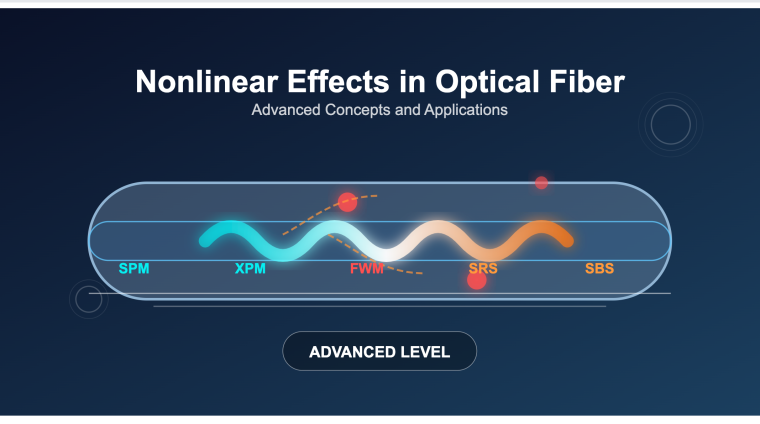
Courses you might be interested in
Advanced Technologies
-
42 Lessons
Advanced Technologies
-
51 Lessons
Advanced Technologies
-
53 Lessons
Advanced Technologies
-
44 Lessons


